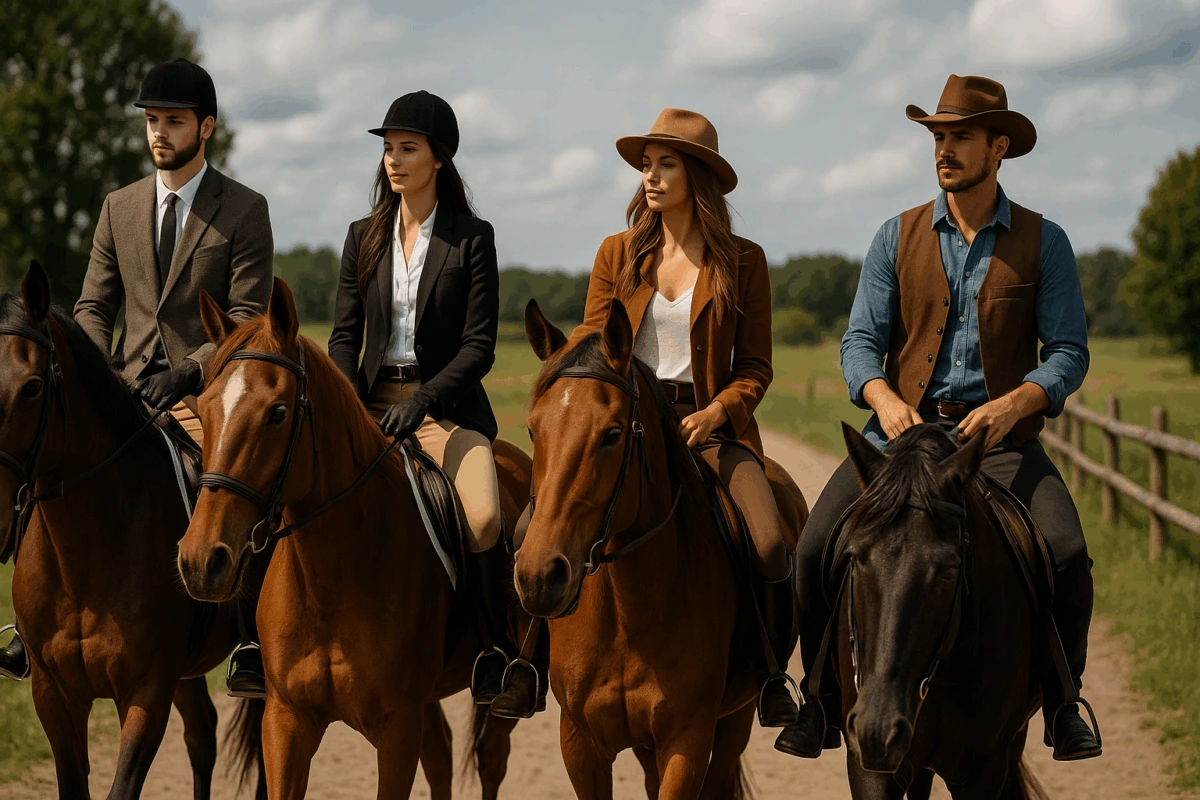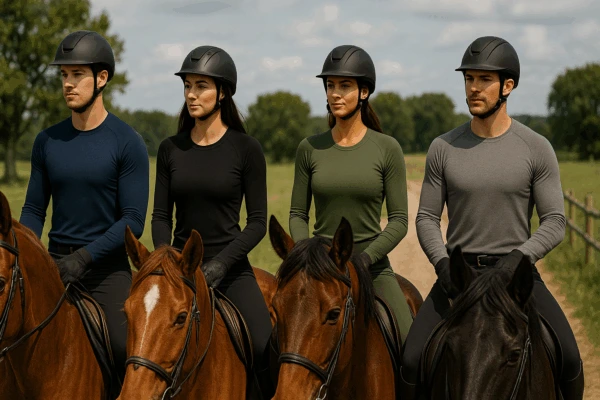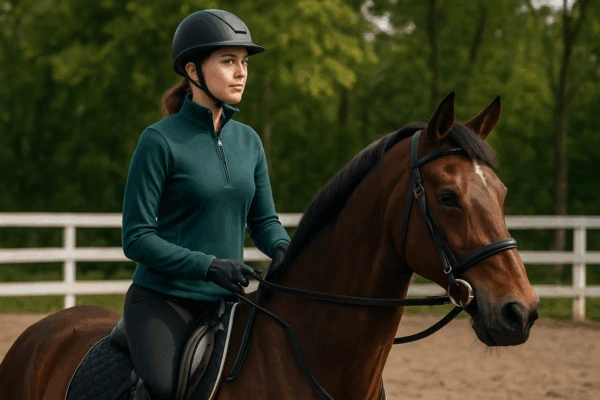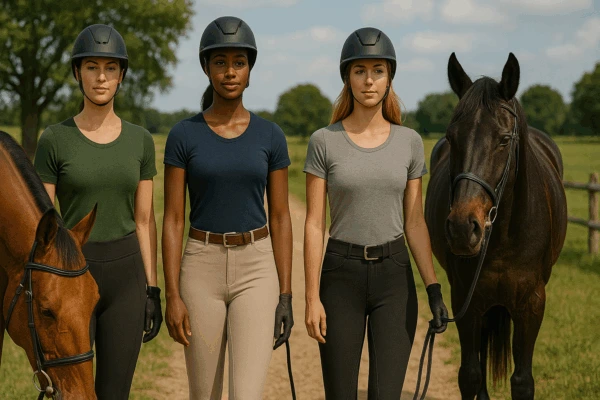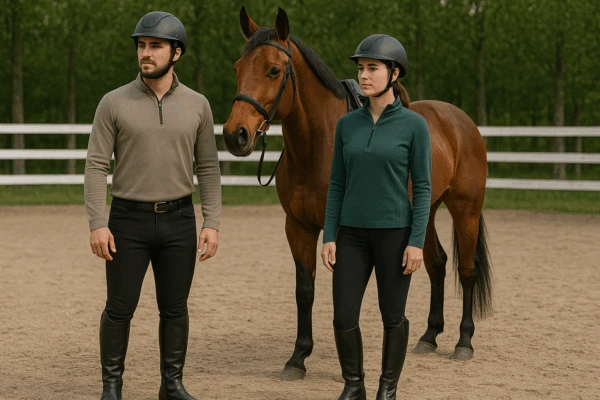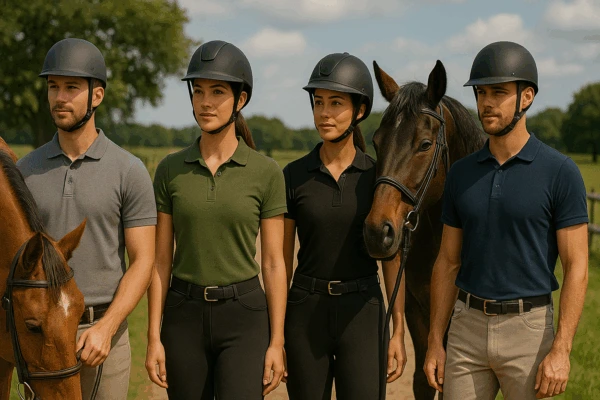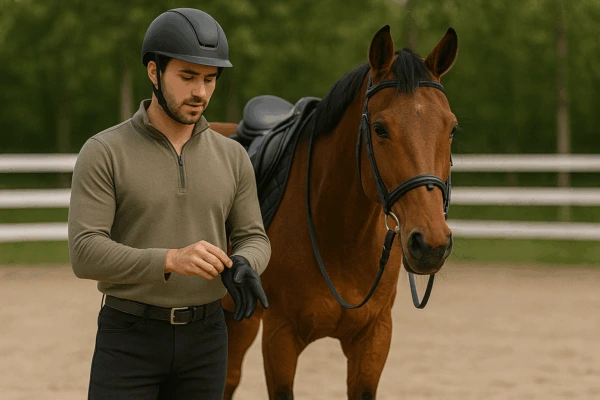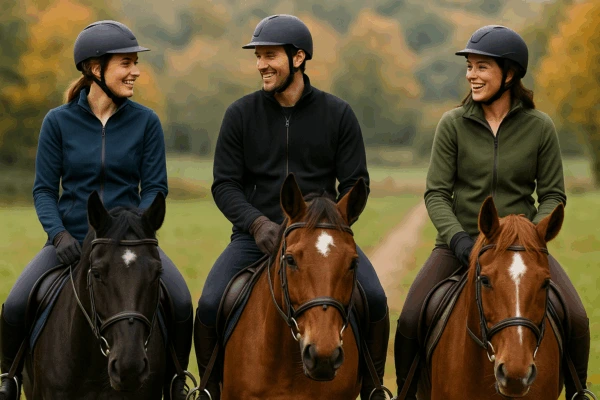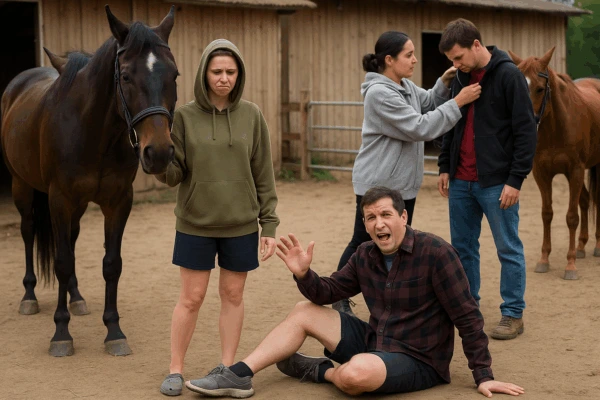What to Wear for Horse Riding: Safety, Style & Comfort
Horse riding is a rewarding sport that combines skill, connection with animals, and the great outdoors—but it also comes with risks. Whether you’re saddling up for the first time or you’re a seasoned equestrian, what you wear can significantly impact your safety, comfort, and the wellbeing of your horse.
The right attire ensures protection in the saddle, prevents injuries, and allows full freedom of movement. It also helps you stay comfortable in changing weather conditions and reduces distractions while riding.
In this guide, we’ll walk you through exactly what to wear for horse riding—from base layers and boots to helmets and seasonal gear—so you can ride with confidence, style, and safety every time you step into the stirrups.
Base Layers: The Foundation of Every Riding Outfit
When it comes to horse riding, base layers are more than just an undergarment, they’re a functional foundation that helps regulate your body temperature and keep you comfortable in the saddle. Whether you’re riding on a frosty winter morning or in the heat of summer, a good base layer works to wick away sweat, manage moisture, and prevent you from getting too cold or overheating.
Most modern riding base layers are made from lightweight, breathable fabrics with moisture-wicking technology that draws sweat away from the skin. Many also offer built-in UV protection (usually UPF 30–40), making them especially valuable for long hours riding outdoors in warmer months. These technical materials help reduce the risk of sunburn and skin irritation while maintaining airflow and flexibility.
In summer, opt for short-sleeved or sleeveless base layers made from cooling, quick-dry fabrics. They keep you dry and shielded from the sun, especially when paired with lighter riding leggings or breeches. In winter, long-sleeved thermal base layers are ideal for layering under sweatshirts, riding coats, or softshell jackets. Look for brushed or fleece-lined interiors for added warmth without bulk.
No matter the season, a well-chosen base layer helps you stay focused on your ride—not your outfit. It’s a small investment that makes a big difference in how you feel, move, and perform on horseback.
Read More: Why Custom Riding Shirts are a Game Changer for Horse Lovers
Mid Layers for Every Riding Season
Mid layers are a key part of your horse riding wardrobe, especially when the weather is unpredictable. These pieces provide an extra layer of warmth while remaining breathable and easy to move in. Whether you’re tacking up, riding, or cooling down after a session, having the right mid-layer ensures you’re prepared for changing conditions without overheating or feeling restricted.
For riders, half-zip sweatshirts or full-zip tops are the most practical options. Why? Because they’re easy to remove or adjust without taking off your riding helmet. That makes them ideal for both casual rides and more intense training sessions, where temperature and comfort can change quickly.
Look for sweatshirts made from thermo-regulating fabrics that help balance your body heat throughout the ride. Many also feature soft fleece linings for added insulation, while maintaining breathability to keep sweat from building up. V-neck jumpers are another great option, especially in milder weather, they’re more breathable and sit comfortably under a riding jacket or coat.
Lightweight mid-layers can also double as casual wear around the stable. Their combination of function and style means you won’t need to change before grabbing coffee after your ride. With various fits, styles, and colors available, it’s easy to find one that matches your personal riding look while still being totally practical.
Riding Leggings, Breeches & Jodhpurs: Comfort Meets Performance
When it comes to riding bottoms, not all styles are created equal. The right choice will not only make you more comfortable but can also improve your riding experience by enhancing mobility, grip, and contact with the horse.
Let’s start with the most versatile option: riding leggings. These are a favorite among modern riders for a reason: they’re made from lightweight, stretchy, and moisture-wicking fabric, perfect for staying cool during lessons or long hacks. Many designs now include side phone pockets, making them practical both in and out of the saddle. Their pull-on fit and flexible feel offer ease of movement, especially for beginners or those in frequent training.
If you’re looking for a more structured, traditional style, breeches and jodhpurs are excellent options. Breeches are designed to end just above the ankle, which pairs well with long riding boots. They typically come with reinforced knee or full-seat grip panels to support better stability and control in the saddle. Meanwhile, jodhpurs extend down to the ankle and are best worn with short boots and half chaps. Their tailored, snug fit helps riders maintain steady leg contact, especially useful in flatwork or dressage.
No matter which type you choose, fit is critical. Your trousers should stay securely in place without feeling tight or bulky. Loose or slipping fabric can cause chafing, reduce contact with the saddle, and become distracting during movement. Always look for materials that stretch, breathe, and support your natural riding posture.
Whether you’re just starting out or competing regularly, a well-fitted pair of riding bottoms is one of the smartest investments you can make for your comfort and performance.
Riding Boots & Footwear: Finding the Right Pair for Safety and Comfort
Choosing the right footwear is essential for any rider, as boots provide not only protection but also support and grip that can affect your control and safety in the saddle.
There are two main types of riding boots to consider. Short boots, often called jodhpur or paddock boots, are popular among beginners and casual riders. These boots typically reach just above the ankle and are worn with half-chaps, which cover the lower leg and provide extra grip and protection. This combination is versatile and practical, allowing for better ankle flexibility and easier walking when off the horse.
For riders seeking enhanced support and a refined appearance, long boots are the preferred choice. Rising to just below the knee, these boots provide extra stability to the lower leg, helping riders keep a steady and close contact with their horse. This close fit supports better communication through subtle leg movements, which can be critical for precise riding techniques.
No matter which style you pick, there are important features every riding boot should include. A heel height between 1 and 1.5 inches is essential to prevent your foot from sliding too far through the stirrup, which helps reduce the risk of getting stuck during a fall. Additionally, the sole should have enough grip to prevent slipping but not be so sticky that it hampers quick release when needed.
Overall, selecting boots that combine safety, comfort, and functionality according to your riding style will make your time in the saddle safer and more enjoyable.
Helmet & Headgear: Protecting Your Most Valuable Asset
When it comes to riding, nothing is more important than protecting your head. A properly fitted, certified riding helmet is the single most essential piece of safety gear every rider should wear—whether you’re a beginner or an experienced equestrian. Helmets certified by recognized organizations like ASTM (American Society for Testing and Materials), SEI (Safety Equipment Institute), PAS (British standard), or VG1 (European standard) meet strict safety requirements to help reduce the risk of serious head injury.
There are different helmet styles suited for various riding disciplines. Skull caps are designed without a brim, offering a clean and unobtrusive look, making them a popular choice for casual riding and cross-country disciplines. Meanwhile, helmets with a small peak or visor are often preferred in dressage and showjumping to help shield your eyes from sun and rain. Regardless of style, good ventilation is key for comfort during long rides, and an adjustable harness ensures the helmet stays securely in place.
When fitting a helmet, it should sit level on your head, resting just above your eyebrows and covering the forehead without pressing uncomfortably. It needs to be snug enough so it doesn’t move when you shake your head but not so tight that it causes pain. When fastened, the helmet should feel secure and stable, offering peace of mind every time you ride.
A crucial safety tip: never buy a second-hand helmet. You can’t be sure if it has suffered any invisible damage that could compromise protection. Helmets must be replaced following any impact because, even if no external damage is visible, the internal protective components could be compromised.
Investing in a quality helmet that fits well is the best way to protect yourself while enjoying the thrill and joy of horseback riding.
Choosing the Right Body Protectors
When it comes to rider safety, body protectors—also known as safety vests—play a critical role in minimizing the risk of serious injuries during falls or impacts. These vests are specifically designed to absorb shocks and protect vulnerable areas such as the ribs and spine from potential trauma caused by kicks or collisions. Wearing a body protector can be especially important in disciplines with a higher risk of falls, such as eventing or cross-country riding.
To ensure maximum protection, body protectors should meet recognized safety standards. The most common certifications include BETA Level 3 and EN 13158:2009 or the updated 2018 standard. These certifications guarantee that the vest has undergone rigorous testing for impact absorption and durability, making them suitable for both general riding and competitive environments.
Proper fit is essential for effectiveness. A body protector should fit closely around the chest and waist to stay secure, while still allowing freedom of movement, and it needs to be long enough to provide proper coverage along the spine. Because sizing can vary between brands, it’s highly recommended to get professionally fitted. An ill-fitting vest may shift during riding, reducing its protective capabilities or causing discomfort.
In summary, investing in a certified body protector and ensuring a correct fit can significantly enhance rider safety, providing peace of mind and better protection while enjoying equestrian activities.
Essential Gloves and Accessories for Comfortable Riding
When it comes to riding, gloves are more than just a style statement—they’re essential for protecting your hands and improving your grip on the reins. Most riding gloves are made from lightweight, flexible materials like Lycra or spandex, or soft leather that feels comfortable against the skin. These gloves are designed to be thin enough to maintain sensitivity, allowing riders to feel subtle movements through the reins while still offering protection from friction and blisters. Many feature small grip-enhancing dots or textured palms to prevent slipping, which is crucial for maintaining control during rides.
In addition to gloves, other accessories play important roles in comfort and performance. Headbands or ear warmers help keep riders cozy during chilly weather without the bulk of a full hat, while underlayer bras and seamless underwear are popular choices for preventing chafing during long sessions. These small but thoughtful accessories can make a big difference in keeping riders comfortable, focused, and connected to their horses.
Outer Layers: Jackets & Coats
The right outerwear can make all the difference between a miserable ride and a comfortable one—especially when the weather turns. For milder or transitional seasons, softshell and fleece jackets are excellent choices. Softshell jackets are lightweight, breathable, and often shower-resistant, while fleece jackets provide warmth without bulk. Both are great as mid-layers or stand-alone pieces in dry weather, offering flexibility and movement in the saddle.
When winter sets in, it’s worth investing in a riding-specific coat. Look for waterproof or quilted jackets that are insulated for warmth, yet designed with riding in mind—features like back vents, two-way zips, and high collars all contribute to practicality. Long riding coats with rear slits or gussets are ideal for protecting your legs while still allowing you to sit comfortably in the saddle.
Fit is key: your jacket should leave room for layering underneath and allow free movement, particularly through the shoulders and arms. If your jacket is too tight, it might limit how well you can move your arms and handle the reins. On the flip side, an overly loose fit can ride up or get in the way while you’re in the saddle.
What Not to Wear for Horse Riding
Knowing what not to wear is just as important as choosing the right gear—especially when your safety and your horse’s well-being are on the line. Let’s start with the basics: shorts are a definite no. They offer no protection and can cause painful rubbing against the saddle. Similarly, sandals, trainers, or hiking boots might seem comfortable, but they’re not designed for riding. They can get stuck in stirrups, lack the right heel for safety, and offer little protection if a horse steps on your foot.
Loose, baggy clothing—especially oversized jackets or scarves—can get caught on tack or branches if you’re out hacking. And while hoodies may feel cozy, their dangling drawstrings or loose hoods can easily snag, posing a serious risk to both rider and horse.
Most importantly, never ride without a helmet, no matter how experienced you are or how slow you’re going. Even a quiet horse can spook unexpectedly, and a fall at walking pace is still dangerous if your head isn’t protected.
Horse riding is fun and freeing, but only when done safely. Dressing correctly keeps you confident and out of harm’s way.
Dress with Purpose, Ride with Confidence
Wearing the right gear for horse riding isn’t just about style—it’s a matter of safety, performance, and respect for your horse. From helmets to boots, every piece plays a crucial role in keeping you protected and comfortable in the saddle.
Whether you’re a beginner learning the basics or an experienced rider training for competition, investing in well-fitted, purpose-built clothing enhances your experience and minimizes risks. Always dress for the weather, choose certified safety equipment, and avoid casual wear that could compromise your safety. Proper attire empowers you to ride with confidence, focus, and freedom—so you can fully enjoy the ride.

